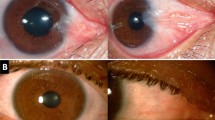Abstract
To evaluate the results of pterygium excision with conjunctival autograft transplantation for primary pterygium performed by trainee ophthalmologists. Design Prospective interventional case series. Setting A tertiary eye care center in northern Thailand. Participants Patients with primary pterygium recruited from July 2011 to August 2012. Intervention In all cases, the affected eye underwent pterygium excision followed by a superior conjunctival autograft carried out by trainee ophthalmologists. Main outcome measure The recurrence of pterygium and other post-operative complications. Results Sixty-two eyes from 54 patients were studied. There were 36 females (66.7 %) and 18 males (33.3 %). The mean age of the patients was 54.5 (±9.8) years with the mean corneal invasion measured at 3.3(±0.8) mm. Pterygium morphologies of Grade 1, Grade 2, and Grade 3 were 33.9, 48.4, and 17.7 %, respectively, with the mean follow-up time of 17.3 (±7.9) months. Pterygium recurred in the cornea of six eyes (9.7 %). All recurrences occurred within 6-month post-operation. Other post-operative complications included conjunctival recurrence (4.8 %), graft retraction (3.2 %), conjunctival cyst (3.2 %), and increased intraocular pressure (1.6 %). The recurrence of pterygium was not associated with the patient age (p = 0.72), occupation (p = 0.23), sun exposure time (p = 0.18), pterygium duration (p = 0.22), pterygium size (p = 0.67), or pterygium morphology (p = 0.85). Conclusion The recurrence rate and post-operative complications of pterygium excision with conjunctival autograft performed by trainee ophthalmologists were within acceptable limits. All recurrence occurred within 6 months after surgery.



Similar content being viewed by others
References
Coroneo MT (1993) Pterygium as an early indicator of ultraviolet insolation: a hypothesis. Br J Ophthalmol 77:734–739
Taylor HR (1980) Aetiology of climatic droplet keratopathy and pterygium. Br J Ophthalmol 64:154–163
McCarty CA, Fu CL, Taylor HR (2000) Epidemiology of pterygium in Victoria, Australia. Br J Ophthalmol 84:289–292
Gazzard G, Saw SM, Farook M, Koh D, Widjaja D, Chia SE et al (2002) Pterygium in Indonesia: prevalence, severity and risk factors. Br J Ophthalmol 86:1341–1346
Wong TY, Foster PJ, Johnson GJ, Seah SK, Tan DT (2001) The prevalence and risk factors for pterygium in an adult Chinese population in Singapore: the Tanjong Pagar survey. Am J Ophthalmol 131:176–183
Tan DT, Chee SP, Dear KB, Lim AS (1997) Effect of pterygium morphology on pterygium recurrence in a controlled trial comparing conjunctival autografting with bare sclera excision. Arch Ophthalmol 115:1235–1240
Hirst LW (2003) The treatment of pterygium. Surv Ophthalmol 48:145–180
Chen PP, Ariyasu RG, Kaza V, LaBree LD, McDonell PJ (1995) A randomized trial comparing mitomycin C and conjunctival autograft after excision of primary pterygium. Am J Ophthalmol 120:151–160
Ti SE, Tan DT (2003) Tectonic corneal lamellar grafting for severe scleral melting after pterygium surgery. Ophthalmology 110:1126–1136
Tarr KH, Constable IJ (1980) Late complications of pterygium treatment. Br J Ophthalmol 64:496–505
Kenyon KR, Wagoner MD, Hettinger ME (1985) Conjunctival autograft transplantation for advanced and recurrent pterygium. Ophthalmology 92:1461–1470
Ma DH, See LC, Liau SB, Tsai RJ (2000) Amniotic membrane graft for primary pterygium: comparison with conjunctival autograft and topical mitomycin C treatment. Br J Ophthalmol 84:973–978
Prabhasawat P, Barton K, Burkett G, Tseng SC (1997) Comparison of conjunctival autografts, amniotic membrane grafts, and primary closure for pterygium excision. Ophthalmology 104:974–985
Luanratanakorn P, Ratanapakorn T, Suwan-Apichon O, Chuck RS (2006) Randomised controlled study of conjunctival autograft versus amniotic membrane graft in pterygium excision. Br J Ophthalmol 90:1476–1480
Tananuvat N, Martin T (2004) The results of amniotic membrane transplantation for primary pterygium compared with conjunctival autograft. Cornea 23:458–463
Chaidaroon W, ThongKhao-Om M, Wiwatwongwana D, Wiwatwongwana A (2013) A survey of pterygium surgery in Thailand 2010. J Med Assoc Thail 96:64–68
Ti SE, Chee SP, Dear KB, Tan DT (2000) Analysis of variation in success rates in conjunctival autografting for primary and recurrent pterygium. Br J Ophthalmol 84:385–389
Sebban A, Hirst LW (1991) Pterygium recurrence rate at the Princess Alexandra Hospital. Aust NZ J Ophthalmol 19:203–206
Farrah JJ, Lee GA, Greenrod E, Vieira J (2006) Outcomes of autoconjunctival grafting for primary pterygia when performed by consultant compared with trainee ophthalmologists. Clin Exp Ophthalmol 34:857–860
Chalioulias K, Dwarika D, Thakur S (2007) Pterygium excision with conjunctival autograft: consultant versus trainee. Clin Exp Ophthalmol 35:396 (author reply)
Ma K, Xu L, Jie Y, Jonas JB (2007) Prevalence of and factors associated with pterygium in adult Chinese: the Beijing Eye Study. Cornea 26:1184–1186
Lewallen S (1989) A randomized trial of conjunctival autografting for pterygium in the tropics. Ophthalmology 96:1612–1614
Acknowledgments
This study was supported by the Faculty of Medicine Endowment Fund, Faculty of Medicine, Chiang Mai University (Grant number 16/2555). All authors declare no conflict of interest. The authors are grateful to Mrs. Rodjana Peugchanteug, MSc, for assisting in statistical analysis.
Author information
Authors and Affiliations
Corresponding author
Ethics declarations
Conflict of interest
No conflict of interest is declared.
Rights and permissions
About this article
Cite this article
Kositphipat, K., Tananuvat, N. & Choovuthayakorn, J. Results of pterygium excision adjunct with conjunctival autograft transplantation for primary pterygium by ophthalmology trainees. Int Ophthalmol 36, 615–621 (2016). https://doi.org/10.1007/s10792-016-0175-x
Received:
Accepted:
Published:
Issue Date:
DOI: https://doi.org/10.1007/s10792-016-0175-x




